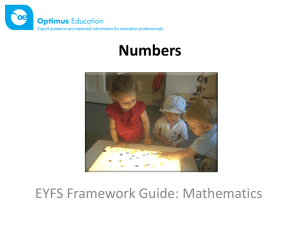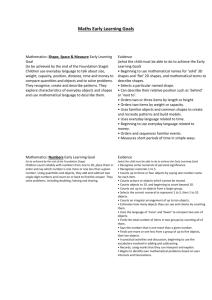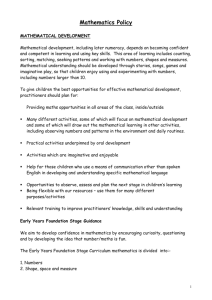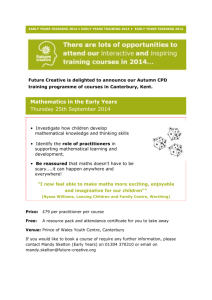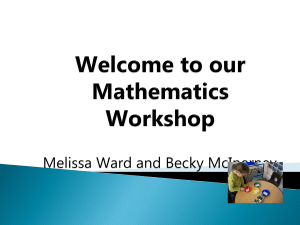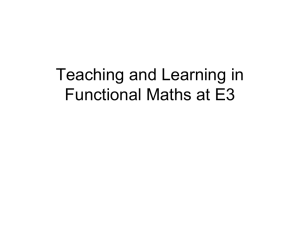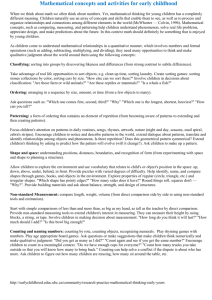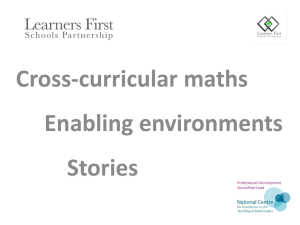Problem Solving in the Early Years
advertisement
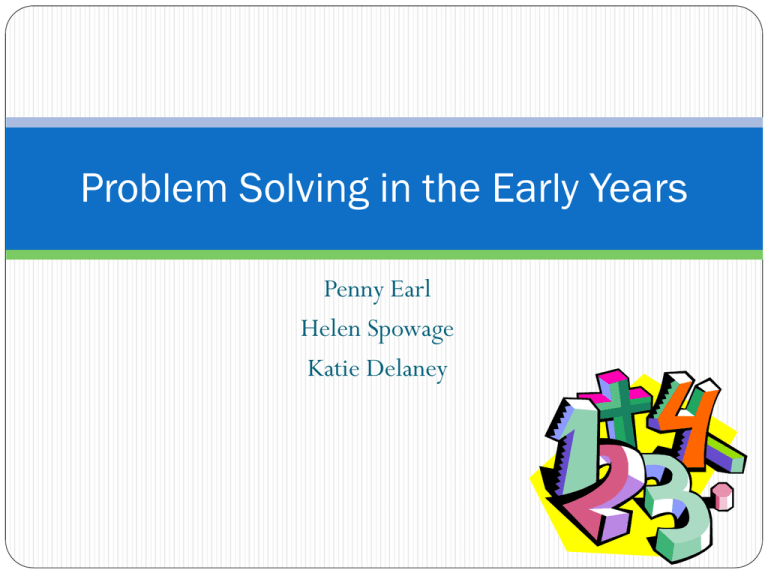
Problem Solving in the Early Years Penny Earl Helen Spowage Katie Delaney Introductions Penny Helen Katie Delegates – you are a diverse audience!! Preschools, nurseries, day care, infant schools, junior schools, primary schools. North Lincs, North East Lincs EYFS Statutory Framework Areas of Learning and Development Prime Specific Maths 1.6 Educational programmes must involve activities and experiences for children, as follows … … Mathematics involves providing children with opportunities to develop and improve their skills in counting, understanding and using numbers, calculating simple addition and subtraction problems; and to describe shapes, spaces, and measures. Early Learning Goal 11: numbers Children count reliably with numbers from one to 20, place them in order and say which number is one more or one less than a given number. Using quantities and objects, they add and subtract two single-digit numbers and count on or back to find the answer. They solve problems, including doubling, halving and sharing. Explanatory note: Within play and other practical situations, the child counts and orders numbers from 1-20 and finds one more or one fewer than a given number. Using every day and play objects, the child applies a range of strategies to add and subtract quantities involving two single-digit numbers such as counting on to add and counting back to subtract. In a range of practical and play contexts the child explores and solves problems involving doubling, halving and sharing, utilising his or her own methods. Early Learning Goal 12: shape space and measures Children use everyday language to talk about size, weight, capacity, position, distance, time and money to compare quantities and objects and to solve problems. They recognise, create and describe patterns. They explore characteristics of everyday objects and shapes and use mathematical language to describe them. Explanatory note: The child uses everyday language to share their thinking about size, weight, capacity, position, distance, time and money. The child demonstrates that they understand that one quantity is different to another even if they do not know the correct comparative term. The child is able to recognise and describe patterns and notices them in the environment. The child makes patterns using a range of media and resources. The child notices and describes everyday objects and shapes using appropriate mathematical language. Westwoodside Church of England Primary School Challenge Books Floor Books Ofsted … has yet to provide further opportunities to fully support younger children’s awareness of number, shape, space and measure during every day play opportunities … does not fully maximise opportunities to consistently support younger children’s awareness of number during daily play and activities …opportunities to use mathematical language in a variety of situations are sometimes missed Ofsted ….does not yet provide opportunities for older children to develop mark making skills Assessments of some children’s progress have yet to include their achievements within the specific areas of learning. This information has then yet to be used to plan future challenging experiences to effectively ensure children are making progress across all areas of learning. Provision - environment How can you use the environment to support mathematical development? Numbers and Patterns Enabling Environments – potential opportunities for enhancing day to day provision Learning Environment Audit – indoor and outdoor Development Matters Provides support for what adults can do, and what they can provide Songs and rhymes Important for introducing, reinforcing and consolidating not just numbers and their names, but also mathematical concepts and early counting skills Do we give enough thought to what these types of rhymes actually achieve? Are in danger of thinking that all number rhymes and songs are beneficial to all children at all stages of their development? Analyse the mathematical concepts held within each rhyme and, in a truly mathematical approach, find the right sequence in which to present them. ICT resources Study Ladder – free; teacher and child log ons ) http://www.studyladder.co.uk/) TES iBoard – subscription, but some free resources Apps – many and varied Interactive resources – Interactive Teaching Programs (ITPs), Smart Notebook Supporting Learning and Development Long term thinking Opportunities for maths through play Planning throughout the day Westwoodside Church of England Primary School Creativity in Maths Characteristics of Effective Learning Playing and exploring – engagement Finding out and exploring Playing with what they know Being willing to ‘have a go’ Active learning – motivation Being involved and concentrating Keeping trying Enjoying achieving what they set out to do Creating and thinking critically – thinking Having their own ideas Making links Choosing ways to do things EYFS Statutory Framework Planned, purposeful play A mix of adult-led and child-initiated activity Play is essential for children’s development Children learn by leading their own play, and by taking part in play which is guided by adults. Respond to each child’s emerging needs and interests Shift towards more adult led activity as development allows What’s out there… Children thinking Mathematically Mark Making Matters Numbers and Patterns Development Matters Internet resources – computer, tablet Interactive resources Training What’s next for you?
